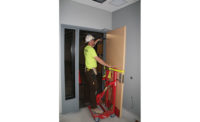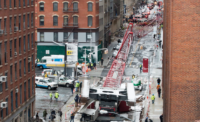Construction companies can’t afford to scrimp on jobsite safety because even a single accident comes at too high a price, say industry professionals and insurers.
However, the growing availability of safety wearables, site sensors, exoskeletons, image-generating drones and other safety-oriented systems raises a key question: Are the results they provide worth the costs, particularly among contractors with limited dollars at their disposal?
As expected, the answers vary. Insurers and risk-management consultants such as Schaumburg, Ill.-based Zurich North America continually take a “fresh look” at safety plans and operations, assisting contractors of all sizes in identifying initiatives best suited for reducing their exposure, says James Boileau, construction segment director with Zurich.
“We perform cost-benefit analyses, weighing incentives, including lower insurance and workers compensation expenses, against the costs associated with OSHA fines and reputational and property damage,” he says. “We ask, ‘What initiatives make sense for the firm, given its exposure?’ But what makes senses for contractor A may not make sense for contractor B.”
Deeper investment in technological innovation may or may not figure into the equation. Wearables—including GPS- or RFID-based devices worn by tradespeople—allow on-site managers to monitor worker locations and movements in real time via wireless, cloud-based mobile interfaces. Some, including an RFID-based system adopted by Kansas City, Mo.-based contractor JE Dunn Construction, “identify worker presence on site, as well store information on worker training and capabilities,” says Matt Ogle, a regional safety manager with JE Dunn.
The system also is equipped with evacuation alerts that site supervisors can deploy in the event of weather disturbances or other hazards near the site, he says. However, one school of thought suggests wearables may prove more beneficial for large, complex, heavily populated sites that are more frequently associated with larger firms rather than smaller ones.
Beyond the use of wearables, smaller firms can—and should—leverage technologies at their disposal, including smart phones to group-text colleagues about safety-related information that includes descriptions and photographs, Ogle says. Likewise, they can use phones to download apps with real-time weather forecasts and alerts, like WeatherBug.
“Technology plays a wonderful role in keeping workers safe during activities such as large excavations, when a wearable will advise of my proximity to another worker, but it always should be regarded as a tool,” says Rodney Spencley, corporate director of safety, quality and labor relations with Redwood City, Calif.-based DPR Construction. “People are the answer. The key is engagement with your craftsmen and trade partners so that when you request they perform a safety-related task, it’s with the understanding we want to send them home safely every day,” he says.
Other Safety Initiatives
A firm’s size notwithstanding, “There are plenty of safety improvements to be had exclusive of new technology, from safety training and pre-task planning to health education and employee drug and alcohol programs,” says Tim Batz, regional risk control team leader for IMA Inc., a Wichita, Kan.-based commercial insurance broker and provider of risk-management solutions.
Providence, R.I.-based CM Gilbane Inc., among the world’s largest builders, spent a decade developing Gilbane Cares, a program predicated on the development of a safety-oriented culture that inspires workers to look after one another. “Relationships are free,” says Rebecca Severson, Gilbane’s corporate safety director.
Although the firm equips its trades with RFID-based wearables, in this instance clips that include altimeters to identify worker altitudes and accelerometers to calculate speeds, including those denoting falls, “We’re adopting new systems to enhance a culture we’ve already established,” Severson says. In addition to classroom and interactive training of field subcontractors, cornerstones of the culture include risk-identification analysis and executive support and involvement, she says.
Numerous firms, large and small, likewise have developed programs to promote greater enterprise-wide engagement, from classroom training and toolbox talks to accountability matrices that extend from the CEO to laborers, says Ogle. JE Dunn, for instance, is shifting more safety-related responsibility to on-site project managers and superintendents. The same is true of DPR, Spencley says.
Due to the considerable time, effort and resources they’ve expended implementing or upgrading safety programs, many firms take a measured approach to adopting new technologies, according to Boileau. “Improvements are smaller due to initiatives they’ve steadily undertaken over the past 20 years,” he says.
Accordingly, several new technologies are in the early phases of adoption, says Batz. “We’ve yet to see widespread use of wearables,” he notes. “They can be expensive, and the technology is rapidly evolving. The thinking is, ‘Why not wait to invest until all the kinks are worked out?’ ”
Newer features involve body mechanics—or evaluations of task-related movements—to prevent soft-tissue injuries. Also emerging are capabilities that detect heart rate and body temperature.
Some firms and workers remain hesitant about the use of wearables due to privacy concerns. “There’s this feeling of ‘Big Brother is watching me’ we need to dispel by advising potential users that monitoring doesn’t extend beyond the work site,” says Ogle. “We know whether they’re on site or not, but not where they are or what they are doing off-site during their free time. Once they understand that, they’re usually okay with the technology.”
Eyes in the Sky
Although drones have been subject to considerable hype, including a recent Goldman Sachs study reporting worldwide construction investment of $11 billion in the technology, Batz says he isn’t seeing systems flying off shelves, despite their ability to capture project progress, quality or safety via photographs and videos. “Among our several hundred clients, only a handful employ them,” he says. “Nevertheless, they hold considerable promise for roofing contractors and other disciplines seeking to gather imagery to perform inspections or prepare quotes without exposing workers to fall hazards.”
Drones also may assist in monitoring sites for hazards such as missing guardrails or workers who have removed their hard hats.
Some larger firms, including McCarthy Building Cos. and Skanska USA, have enjoyed considerable success with drones, though both companies admittedly have adopted drone programs on a small scale and are progressing from there.
Gilbane, for its part, is investigating the technology but has yet to adopt it, Severson says. “We recognize potential in drones, but we need to further investigate requirements for their use as a business tool,” she notes.
As they dabble in new technologies, builders also are testing matrices for leading safety indicators, rather than depending upon lagging indicators, which report only incidents and accidents, says Batz.
For example, Boston-based Suffolk Construction is auditing multiple sites to gather data predictive of accidents and develop strategies to prevent them, according to Alex Hall, executive vice president of environmental health and safety. “One solution is to ‘engineer out’ risk with approaches such as prefabrication,” he says.





